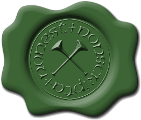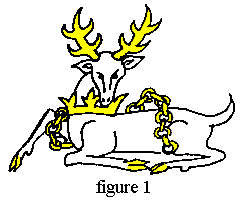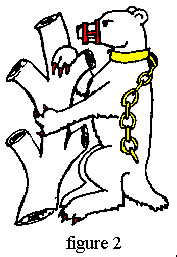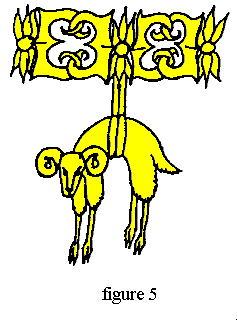
| Home | FAQs | Rules | Archives | Articles | Jobs | Links | KWHSS | OSCAR | SCA.org |
What is an S.C.A Heraldic Badge?
By Dame Zenobia Naphtali
© 1997 Leslie SchweitzerBefore discussing the S.C.A. Heraldic Badge, let’s revisit the S.C.A. heraldic device. An S.C.A. heraldic device (also known as Arms) is a person’s personal logo, equivalent to their signature. It is a heraldic picture that says “this is me; here I am.” In the Middle Ages and Renaissance, many people used a unique heraldic picture as their personal Arms. Most places (such as Baronies and Kingdoms) in the Middle Ages also had Arms. Because the ruling nobles “were” the place they ruled, the territorial Arms were used by the rulers of the territory as if they were their personal Arms.
Heraldry was also used for purposes other than the personal Device or Arms in the Middle Ages. These uses included:
- Personal Badges
- Personal Imprese
- Ensigns or Flags
- Devices and Badges of Associations
- Insignia for Orders and Awards
The Personal Badge
This was a simple piece of heraldry used to identify one’s physical and spiritual possessions. It was used to mark material possessions as well as the clothing of servants and soldiers, to show the fact that they all belonged in some way to the owner of the badge.Badges usually consisted of a single object, or a group of objects which touch other, in a fashion which would allow them to be cast as a single piece of metal jewelry. Personal badges generally did not have a defined background color. They were displayed on any background color, or with no background at all, as with a sign that is cut in the shape of the badge and displayed against the air. . They were often used for decoration. Personal badges looked quite different from the personal Device, which always had a defined background, and which often consisted of a number of seperated, non-touching objects. Some examples are the lodged white hart of King Richard II of England (figure 1) and the Bear and Ragged Staff badge of the Dukes of Warwick (figure 2.)


The personal badge could either be inherited through the generations, like a personal device, or associated with a single person.
The Personal Impresa
 In the Renaissance, particularly in Renaissance
Italy, a new type of insignia arose. Instead of being
a very simple design, like the personal badge, this
type of insignia was generally more complicated. It
represented some philosophical ideal or allegory, and
often had a scroll with a motto in it as part of the
heraldic design.
In the Renaissance, particularly in Renaissance
Italy, a new type of insignia arose. Instead of being
a very simple design, like the personal badge, this
type of insignia was generally more complicated. It
represented some philosophical ideal or allegory, and
often had a scroll with a motto in it as part of the
heraldic design.
These insignia are often known as “imprese” (the Italian term) or “emblems.” Imprese were often designed with a number of separate objects which suggests designing them with a background color for S.C.A. use. Despite their complexity, imprese were used for decoration and to mark objects, just like personal badges,
As an example, figure 3 shows an impresa from Renaissance Milan. It consists of a hand issuing from a radiant cloud, holding a bulging moneybag. The whole design is entwined by a motto scroll, which in Italian means either “when the time is right” or “when the weather is right.” This impresa refers to a philosophy on when to give money. The cloud plays on the “weather” meaning of the motto.
Ensigns and Flags
 These are used to show one’s allegiance to, or after a
fashion, possession by, a territory. Because Arms are
like a personal signature, the Arms of a Kingdom
properly were only used by the personal
embodiments of the Kingdom, their King and
Queen. Private individuals would not use the
Kingdom Arms except in contexts making it
absolutely clear that those Arms were used in
reference to the King and Queen, not to themselves.
These are used to show one’s allegiance to, or after a
fashion, possession by, a territory. Because Arms are
like a personal signature, the Arms of a Kingdom
properly were only used by the personal
embodiments of the Kingdom, their King and
Queen. Private individuals would not use the
Kingdom Arms except in contexts making it
absolutely clear that those Arms were used in
reference to the King and Queen, not to themselves.
Subjects of a Kingdom showed their allegiance to that Kingdom by flying a flag, or ensign. Modern flags (and some ensigns and flags from the end of the S.C.A. time period) have a specified background color and use a specific object or group of objects in specified colors. S.C.A. flags and ensigns follow this custom.
Ensigns and flags seem to have begun as a general display of a Kingdom badge, and may not have had a fixed color scheme at first. For example, the current flag of Scotland has a blue field with a white saltire (or “cross of St. Andrew”) (Figure 4.) The use of these specific colors for the ensign only dates to the 16th century, but the use of a saltire in some color scheme to show allegiance to the King of Scotland goes back centuries earlier.
Devices and Badges of Associations
In the Middle Ages and Renaissance, various associations such as trade guilds and hospitals used Devices, which were designed just like Personal Devices. Sometimes these groups had badges as well, designed and used like personal badges. S.C.A. guilds can design heraldry to follow one or another of these patterns. S.C.A. Households, which often do not exactly correspond to any historical model, might also use devices and badges of associations as a model for their heraldry.Insignia for Orders and Awards
 These insignia often followed the design style for
personal badges. Sometimes the Order badge would
be combined with other badges in a piece of Order
regalia. As an example, take the livery collar of the
Order of the Golden Fleece, a major chivalric Order
in the Middle Ages, headed by the Duke of
Burgundy. The “fleece” badge of the order is a
pendant on the livery collar. The chain of the collar
itself is made of linked plaques symbolizing fire-
steels and flints issuing small sparks or flames. The
fire-steel and flint symbol is a badge of the Dukes of
Burgundy. (figure 5).
These insignia often followed the design style for
personal badges. Sometimes the Order badge would
be combined with other badges in a piece of Order
regalia. As an example, take the livery collar of the
Order of the Golden Fleece, a major chivalric Order
in the Middle Ages, headed by the Duke of
Burgundy. The “fleece” badge of the order is a
pendant on the livery collar. The chain of the collar
itself is made of linked plaques symbolizing fire-
steels and flints issuing small sparks or flames. The
fire-steel and flint symbol is a badge of the Dukes of
Burgundy. (figure 5).
The heraldry.sca.org site is copyright 1995-2024 Society for Creative Anachronism, Inc. The copyright of certain portions of heraldry.sca.org are retained by the original contributors as noted.
External links are not part of the heraldry.sca.org web site. Inclusion of a page or site here is neither implicit nor explicit endorsement of the site. Further, SCA, Inc. is not responsible for content outside of heraldry.sca.org. For information on how SCA uses collected and submitted data, please see the Privacy Policy.
Paper texture used with permission from GRSites.com.